The How of The Exhibition
At last – the exhibition is up and the opening night has partied by. Having been here for several months perhaps you might think I would have developed some kind of day-rhythm, some system about creating work, but no, it didn’t really dawn on me that we had to put up something called ‘work’ until five days prior to the show.
Couldn’t I just have stuck up previous projects completed here in Nagoya, in fact, isn’t what they want? Mmm… recently created ‘graphic design’ in an art gallery – don’t think so. Would people be captivated alphabetical index on my subway map unless they were using it? Would people be astounded at the legibility but slightly ‘left-field’ edge of my business cards unless they were choosing someone for business purposes. Call me old-school on this issue, boring even, but the world is not full of GD anoraks just dying to see your choice of idiosyncratic text and it’s hierarchy. My work created in Nagoya was not about to reveal some truth about people and their everyday lives, ‘nor would it get them to think in a different way, and it definitely wouldn’t make them shed a tear, or break a smile. Sure you can put graphic design in gallery but it picks up all sorts of other connotations when it is removed from it’s context. Also certain works pick up artistic value along the way, such as movie or band posters, summing up a feeling or an era in people’s mind. Yes, of course I do believe design can transcend/become ‘art’, but definitely not mine here and now. I suppose I could have tried to communicate why my work was so brilliant and deserves to be classified as art – as it certainly is in my mind – but come on, try doing that in England let alone still strange Japan.
I needed to create something that I cared about, but other people could see and relate to for me to judge myself successful. Perhaps an advantage of studying graphic design over art when asked to present ‘something’ in an art gallery, is that you are aware of the audience, you do care what they think. (Sorry if you realise that all the following paragraph is all most probably paraphrased from both my lecturer, and Jean Baudrillard) You know that your ‘art’ is not autonomous, but in fact you are not shying away from it, you revel around in it’s heteronomy – you desperately want people to understand. ‘Good art’ is not what they, the critics and tutors say, nor is it what your father, friends or next-door neighbours say. I believe good art is like a mirror: you see yourself in it, you can relate to it, you can take from it. Good art is what you, and you alone, find resonance with, be that a bicycle wheel, a plastic straw, or blood. It is not Shakespeare, it is not Hokusai, it is not Picasso, unless you find something in it, something that you understand. What’s the point in teaching eleven year olds to love Shakespeare when they probably don’t know of the nuances of love, romance, tragedy and death. I now know that my art when I was young was lead-minatures, fantasy books, computer games, comics, anything judged to be middle-class and immature. I could relate to all of these things. I knew nothing of the ‘sophistication’ I was being taught in art class, in English, and indeed most other subjects, they just didn’t fit into anything I could comprehend. Now I am asking myself what was the point, what in fact do I remember from any of those lessons. Now with this in mind, I wanted to create an exhibition that people could in fact relate to and wasn’t so abstruse that it left people more clueless then when they walked in, but also I didn’t want it to be, you know, boring.
Ideas had been ambling around, lolling in and out of analysis, but I could not think of anything that had that illustrious ‘something’. I found the obligation of being asked (forcefully committed) to hang something in a gallery incredibly frustrating because finding something useful to say – especially if you are ‘not quite left field enough’ me – is a very pressing task. Blowing small nondescript icons up massive was one idea, but see above paragraphs as to why that was rejected (Andy Warhol’s ghost seemed disgruntled).
On the Monday of the same week of having the exhibition I was doing some absent-minded thinking where suddenly it seemed clear that I should take photographs of people increasing want to be removed from the senses of the ‘real world’. I thought about iPods, earphones, gloves, shoes, houses, air conditioning etc etc. This seemed like an okay idea which people from Japan or Britain could relate to. I wouldn’t usually question where such an epiphany comes from, but strangely the previous week I did two things: watched Dancer in the Dark starring Björk, and read the second chapter of Malcolm Gladwell’s Blink. Dancer in the Dark is a brilliant film where the central character goes blind and all sorts of nasty things happen to her. Chapter two of Blink talked about how we should trust gut instincts, and in many cases there is a logical way our brain deals these sixth-sense moments out. So perhaps the ‘back of my mind’ was figuring out my problem for me by looking at clues in my environment, namely Björk’s lack of sight portrayed so viscerally, provided me with the key to an idea. Admittedly I didn’t stick with this idea for long because it didn’t really inspire me enough, or indeed anybody else I told, but this idea sparked off another quick succession of concepts, one of which was ‘it’. Without that act of ‘procrastination’ I wonder where I would have been.
The final concept was talking about something that I am deeply interested in, but also is designed to be either funny and/or beautiful. Here’s the spiel I wrote for it:
Artists are Tourists…
I find that the behaviours of an artist are very much like that of a tourist – They exploit objects taking them out of context. Artists are also very likely to fall into the trap of liking something just because you’re meant to like it as told by other artists and teachers.
Being an artist I find that I am always looking for that perfect photo, I am not content with just a memory – I need proof of experience. Also in University, school and even friendship systems we are encouraged to display our ‘artistic personality’ through tangible things such as photographs, we are then judged against everybody else’s photographs. Is this what being an artist is?
Similarly, tourists are always looking for that perfect moment with their camera. They are also discontented with just a memory. Tourists usually think there is a need to prove their experience to other people – you know, pass around the photo album and tell a story.
Do you think that perhaps both the artist and tourist would get more from an experience if instead of taking photographs they thought about ‘things’ more e.g. the situation, the people, the ‘real’ experience, the meaning?
I am hoping this exhibition will show the similarity between two groups of people usually thought to be a world apart. Primarily I want this exhibition to make you laugh.
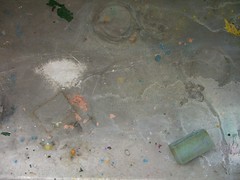
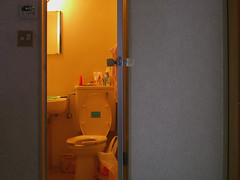

On the wall are a series of über banal shot of ‘things’, specially cropped and coloured to give an ‘arty’ feel (I did actually find most of them beautiful).
And on the side was a photo album of me being a tourist with the super-artzy locations and objects. Here is the second part of the text on the front of the album:
...Tourists are Idiots
As we all know tourists do the most stupid, disrespectful things when they are on holiday. This photo album is to show what I think a lot of artists attitudes are like (including mine). The results may look different, but the reasoning and the method may be more similar than first imagined.
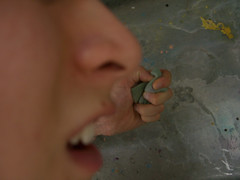
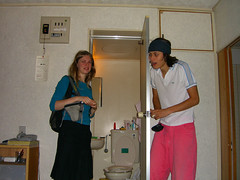
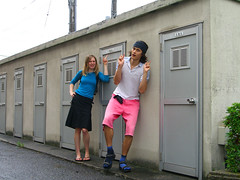
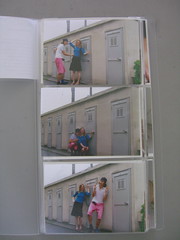
Mmm…yes this idea could have done with a lot more polishing but maybe I’ll scrub it up nice, for a future soirée. I judge this exhibition to be a success not because my work was so astounding that you would suffer from Stendhal syndrome from looking at it, but because I furthered my understanding about how people work. I learnt which way round people are most likely to move around a gallery, what lighting people feel most comfortable with, and most importantly how they read work.
Like Roland Barthes said, (but infinitely more elaborately and eloquently) – people read, not how the author wants them to read, but how they want to read. People who couldn’t read English, could only be bothered to read halfway down my piece descriptions, or misinterpreted what I had said, all had different pieces that they took from my work. When asked about my work one person replied, ‘I have never seen a photograph of a toilet, and door in a gallery. I would never have guessed there was life with these objects and locations.’ So this person thought I was trying to show there was beauty and life everywhere you look, from toilet to door, to dustbin – damned that’s actually a more mature, better concept than mine. Needless to say I didn’t tell them ‘that’s not what it’s about’, I just agreed and said thank you. I couldn’t help thinking of that imbecilic phrase, ‘those who can, do. Those who can’t, teach’, rearranged and reworded to, ‘those who can, do. Those who can’t, take the piss’. Oh dear, I think I’m going to have to do some serious personal personality assessment.
If you would like to see all photos from the exhibition click here
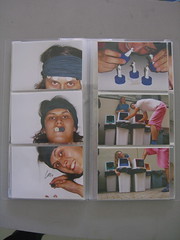
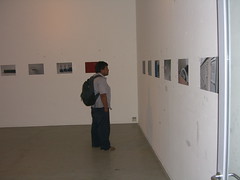
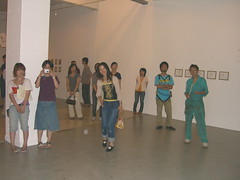
Couldn’t I just have stuck up previous projects completed here in Nagoya, in fact, isn’t what they want? Mmm… recently created ‘graphic design’ in an art gallery – don’t think so. Would people be captivated alphabetical index on my subway map unless they were using it? Would people be astounded at the legibility but slightly ‘left-field’ edge of my business cards unless they were choosing someone for business purposes. Call me old-school on this issue, boring even, but the world is not full of GD anoraks just dying to see your choice of idiosyncratic text and it’s hierarchy. My work created in Nagoya was not about to reveal some truth about people and their everyday lives, ‘nor would it get them to think in a different way, and it definitely wouldn’t make them shed a tear, or break a smile. Sure you can put graphic design in gallery but it picks up all sorts of other connotations when it is removed from it’s context. Also certain works pick up artistic value along the way, such as movie or band posters, summing up a feeling or an era in people’s mind. Yes, of course I do believe design can transcend/become ‘art’, but definitely not mine here and now. I suppose I could have tried to communicate why my work was so brilliant and deserves to be classified as art – as it certainly is in my mind – but come on, try doing that in England let alone still strange Japan.
I needed to create something that I cared about, but other people could see and relate to for me to judge myself successful. Perhaps an advantage of studying graphic design over art when asked to present ‘something’ in an art gallery, is that you are aware of the audience, you do care what they think. (Sorry if you realise that all the following paragraph is all most probably paraphrased from both my lecturer, and Jean Baudrillard) You know that your ‘art’ is not autonomous, but in fact you are not shying away from it, you revel around in it’s heteronomy – you desperately want people to understand. ‘Good art’ is not what they, the critics and tutors say, nor is it what your father, friends or next-door neighbours say. I believe good art is like a mirror: you see yourself in it, you can relate to it, you can take from it. Good art is what you, and you alone, find resonance with, be that a bicycle wheel, a plastic straw, or blood. It is not Shakespeare, it is not Hokusai, it is not Picasso, unless you find something in it, something that you understand. What’s the point in teaching eleven year olds to love Shakespeare when they probably don’t know of the nuances of love, romance, tragedy and death. I now know that my art when I was young was lead-minatures, fantasy books, computer games, comics, anything judged to be middle-class and immature. I could relate to all of these things. I knew nothing of the ‘sophistication’ I was being taught in art class, in English, and indeed most other subjects, they just didn’t fit into anything I could comprehend. Now I am asking myself what was the point, what in fact do I remember from any of those lessons. Now with this in mind, I wanted to create an exhibition that people could in fact relate to and wasn’t so abstruse that it left people more clueless then when they walked in, but also I didn’t want it to be, you know, boring.
Ideas had been ambling around, lolling in and out of analysis, but I could not think of anything that had that illustrious ‘something’. I found the obligation of being asked (forcefully committed) to hang something in a gallery incredibly frustrating because finding something useful to say – especially if you are ‘not quite left field enough’ me – is a very pressing task. Blowing small nondescript icons up massive was one idea, but see above paragraphs as to why that was rejected (Andy Warhol’s ghost seemed disgruntled).
On the Monday of the same week of having the exhibition I was doing some absent-minded thinking where suddenly it seemed clear that I should take photographs of people increasing want to be removed from the senses of the ‘real world’. I thought about iPods, earphones, gloves, shoes, houses, air conditioning etc etc. This seemed like an okay idea which people from Japan or Britain could relate to. I wouldn’t usually question where such an epiphany comes from, but strangely the previous week I did two things: watched Dancer in the Dark starring Björk, and read the second chapter of Malcolm Gladwell’s Blink. Dancer in the Dark is a brilliant film where the central character goes blind and all sorts of nasty things happen to her. Chapter two of Blink talked about how we should trust gut instincts, and in many cases there is a logical way our brain deals these sixth-sense moments out. So perhaps the ‘back of my mind’ was figuring out my problem for me by looking at clues in my environment, namely Björk’s lack of sight portrayed so viscerally, provided me with the key to an idea. Admittedly I didn’t stick with this idea for long because it didn’t really inspire me enough, or indeed anybody else I told, but this idea sparked off another quick succession of concepts, one of which was ‘it’. Without that act of ‘procrastination’ I wonder where I would have been.
The final concept was talking about something that I am deeply interested in, but also is designed to be either funny and/or beautiful. Here’s the spiel I wrote for it:
Artists are Tourists…
I find that the behaviours of an artist are very much like that of a tourist – They exploit objects taking them out of context. Artists are also very likely to fall into the trap of liking something just because you’re meant to like it as told by other artists and teachers.
Being an artist I find that I am always looking for that perfect photo, I am not content with just a memory – I need proof of experience. Also in University, school and even friendship systems we are encouraged to display our ‘artistic personality’ through tangible things such as photographs, we are then judged against everybody else’s photographs. Is this what being an artist is?
Similarly, tourists are always looking for that perfect moment with their camera. They are also discontented with just a memory. Tourists usually think there is a need to prove their experience to other people – you know, pass around the photo album and tell a story.
Do you think that perhaps both the artist and tourist would get more from an experience if instead of taking photographs they thought about ‘things’ more e.g. the situation, the people, the ‘real’ experience, the meaning?
I am hoping this exhibition will show the similarity between two groups of people usually thought to be a world apart. Primarily I want this exhibition to make you laugh.



On the wall are a series of über banal shot of ‘things’, specially cropped and coloured to give an ‘arty’ feel (I did actually find most of them beautiful).
And on the side was a photo album of me being a tourist with the super-artzy locations and objects. Here is the second part of the text on the front of the album:
...Tourists are Idiots
As we all know tourists do the most stupid, disrespectful things when they are on holiday. This photo album is to show what I think a lot of artists attitudes are like (including mine). The results may look different, but the reasoning and the method may be more similar than first imagined.




Mmm…yes this idea could have done with a lot more polishing but maybe I’ll scrub it up nice, for a future soirée. I judge this exhibition to be a success not because my work was so astounding that you would suffer from Stendhal syndrome from looking at it, but because I furthered my understanding about how people work. I learnt which way round people are most likely to move around a gallery, what lighting people feel most comfortable with, and most importantly how they read work.
Like Roland Barthes said, (but infinitely more elaborately and eloquently) – people read, not how the author wants them to read, but how they want to read. People who couldn’t read English, could only be bothered to read halfway down my piece descriptions, or misinterpreted what I had said, all had different pieces that they took from my work. When asked about my work one person replied, ‘I have never seen a photograph of a toilet, and door in a gallery. I would never have guessed there was life with these objects and locations.’ So this person thought I was trying to show there was beauty and life everywhere you look, from toilet to door, to dustbin – damned that’s actually a more mature, better concept than mine. Needless to say I didn’t tell them ‘that’s not what it’s about’, I just agreed and said thank you. I couldn’t help thinking of that imbecilic phrase, ‘those who can, do. Those who can’t, teach’, rearranged and reworded to, ‘those who can, do. Those who can’t, take the piss’. Oh dear, I think I’m going to have to do some serious personal personality assessment.
If you would like to see all photos from the exhibition click here



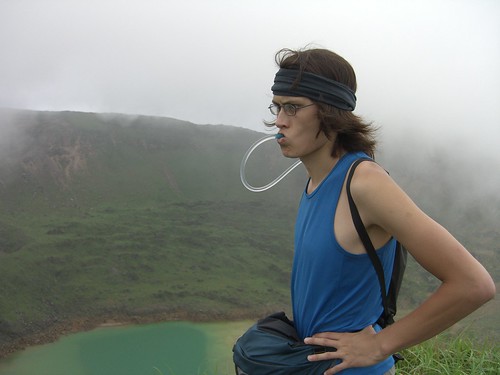
<< Home